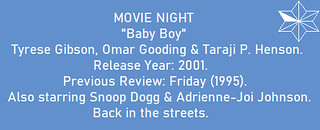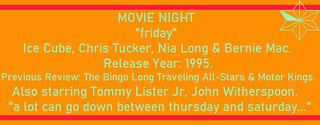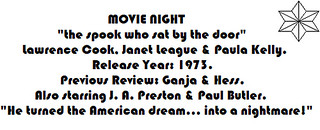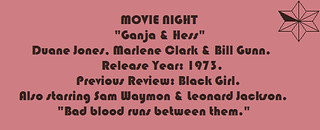Cast:
Featuring the musical talents of Stevie Wonder, Mahalia Jackson, Nina Simone, The 5th Dimension, The Staple Singers, Gladys Knight & the Pips, Blinky Williams, Sly and the Family Stone, The Chambers Brothers, The Edwin Hawkins Singers, Billy Davis Jr, Marilyn McCoo, Greg Errico, Adrienne Kryor, B.B. King, and many more...
Featuring festival attendants Dorina Drake, Barbara Bland-Acosta, Darryl Lewis, Ethel Beatty, Musa Jackson & Roger Parris. Featuring festival participants/organizers/others as themselves: Al Sharpton, Allen Zerkin, Margot Edman, Alan Leeds, Cyril "Bullwhip" Innis Jr, Hal Tulchin, Greg Tate, Charlayne Hunter-Gault, Jesse Jackson, Jim McFarland, Lin-Manuel Miranda, Luis Miranda, Denise Oliver-Velez, Shelia E., Chris Rock, Raoul Roach, Sal Masekela, etc.
Directed by Ahmir "Questlove" Thompson.
Review:
You might wonder why I decided to cap the month off of film featuring black actors and directors with a documentary. Well, I will admit that this film was a last-minute choice, but my reasoning is two-fold: it features several noted musicians of the 1960s in soul, jazz, gospel, and Latin music that range from icons like Stevie Wonder to groups such as Sly and the Family Stone, for which I hadn't heard a number of before. It is also the debut feature film for its directing Ahmir "Questlove" Thompson. The musician/director was born in 1971 in Philadelphia to a family versed in music, and he graduated at the Philadelphia High School for the Creative and Performing Arts, where he founded a band with The Roots, which has done a handful of albums over nearly three decades. Of course, the history covered in this documentary is the foundation for the music that came from it. The 1969 Harlem Cultural Festival, sometimes referred to as the "Black Woodstock", was actually comprised of six concerts, with the first one being on June 29 and the last being on August 24 (Woodstock ran from August 15-18 in Bethel, while the fifth concert of the Cultural Festival played on the 17th), all of which would be hosted at Mount Morris Park [now known as Marcus Garvey Park] in Harlem, New York, complete with free admission. It was organized and hosted by Tony Lawrence, while Hal Tulchin recorded the footage on videotape. Portions were broadcast for two one-hour TV specials in 1969 but afterwards were not seen for decades. The original tapes ran for forty hours, and the process of restoring the tapes alongside editing them down from forty to 24 to two took five months. Of course, the footage wasn't really obscure for so long, since it attracted the interest of film archivist Joe Lauro, a friend of Karl Knudsen (a jazz record label owner), who had in his collection a 16-mm print of "Harlem Festival" that the latter showed the former in 2003 (this was a TV print that was offered to foreign distributors in the early 1970s, which had Tulchin's name on the reel). At any rate, Lauro and his company (Historic Films) came to an agreement with Tulchin to truck out copies of the tapes to digitize and catalog that resulted in licensed clips that could be released on DVD. The idea of turning the footage into a film like what happened with Woodstock (1970) was attempted by Lauro, Morgan Neville, and Robert Gordon but plans to close a deal on finding funding were scuttled by Tulchin and his increasing demands (the two played out their agreement to the end in 2007, and Tulchin died in 2017). Lauro was not mentioned in the film, but at least one can be comforted to note his key place in the long story that saw footage turn into something workable for a film. It was released in both theaters and Hulu (never heard of them) and was nominated for an Academy Award for Best Documentary Feature in 2022.
Of course, it isn't exactly just a musical concert, because there were plenty of presences there besides musicians, whether that involves reverends, ventriloquists, or the Black Panthers, which makes this an interesting time capsule into the close of a decade as vibrant as the sixties were. Tony Lawrence is briefly mentioned when it comes to his entertainer roots that helped in his efforts with the Parks Department of New York City to help with organizing the festival (starting in 1967), although one might not know of his fade into obscurity after the festival (save for accusing the white organizers of fraud that went nowhere). In fact, searching for Lawrence (not stalking, obviously) might have been just as curious as the fact that one doesn't have much information to present about him. This festival had the benefit of being sponsored by General Foods’ Maxwell House Coffee. Further festivals would come and go until 1974, but none were as prolific as this one was. There is a number of highlights to present when it comes to captivating music, such as with the 5th Dimension and their presentation, for which surviving members talk about them being proud to have a stage to play music to help dispel the idea that they had a "white sound". Of course, there are other perspectives to consider from performers who aren't alive to provide further, such as with the dynamic Simone or with the energetic Family Stone (perhaps it isn't surprising that the director's next planned project is about the group). Of course, one can't forget about Stevie Wonder and his distinct talents either, so there is plenty to unpack from a musical standpoint that makes it quite curious. With this being a perspective from 1969, one would not be surprised to see a small part of the film mentioning the moon landing, since it took place during the festival (July 20). Whatever one feels about the momentous occasion (which, you know, is one of the greatest achievements of the past sixty years), at least it is interesting to see the voices of people free to express their opinion with the context of where and what they are dealing with (and, since it isn't just a festival for one particular brand of music, one gets a bit of perspective into music genres such as Latin - for example). Granted, the music is never too far away from one's mind, but it is generally interesting to see what seems different fifty years removed from a moment where music ruled the day(s) in one little spot in Harlem. As a whole, this is a fairly well-done documentary that weaves music and perspective to make a solid debut effort from its director that would be worth viewing for any music aficionado or one curious in documentation of history.
Overall, I give it 9 out of 10 stars.
As always, I am appreciative of having the time required to deliver a month full of interesting films to cover from various decades and doing Black History Month for a second year in a row is no exception. I hope you enjoyed the month in all the varying perspectives, and I hope to have another complete list for next February. Suggestions are always open. As such, it is time for Women's Month for March, so be on the lookout, folks.














